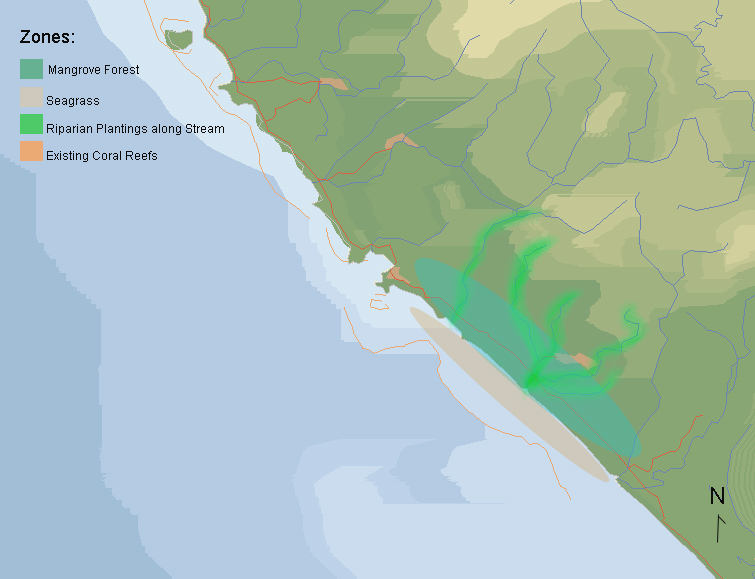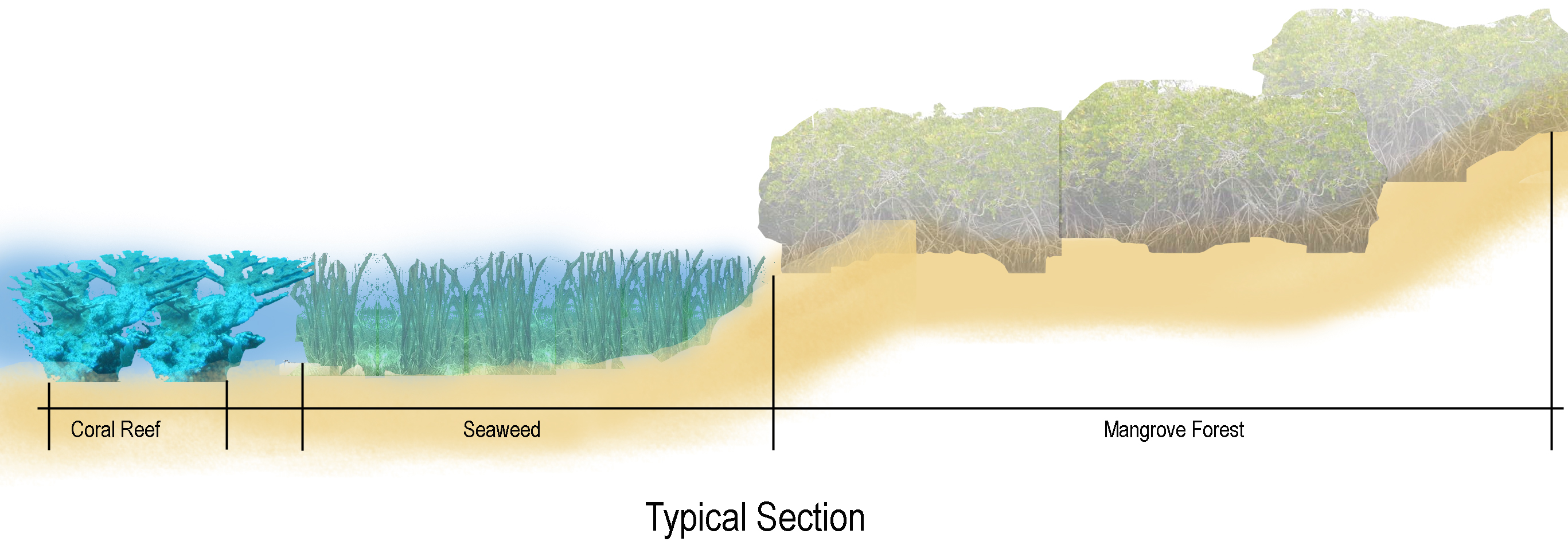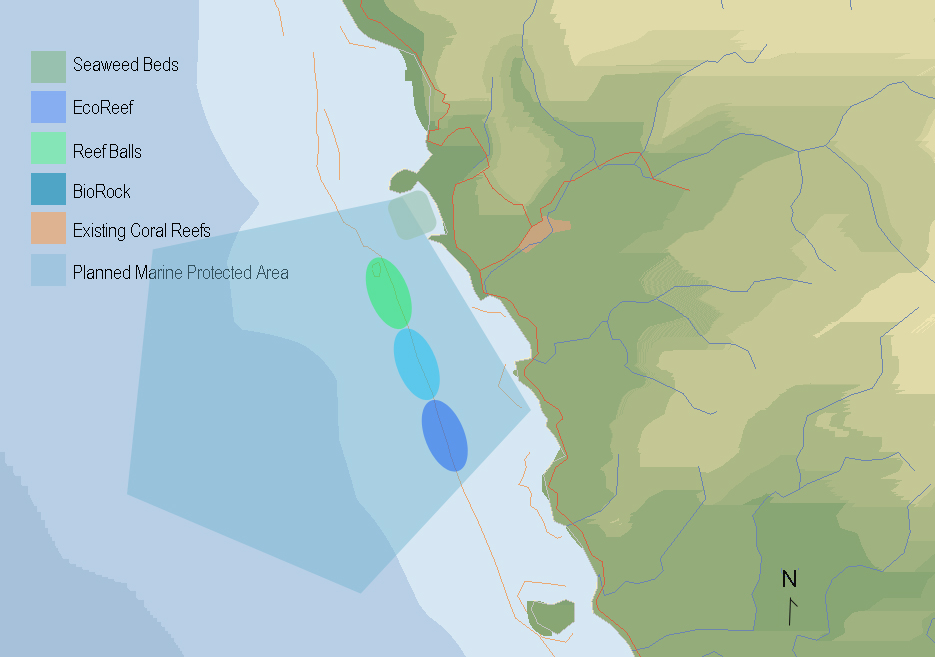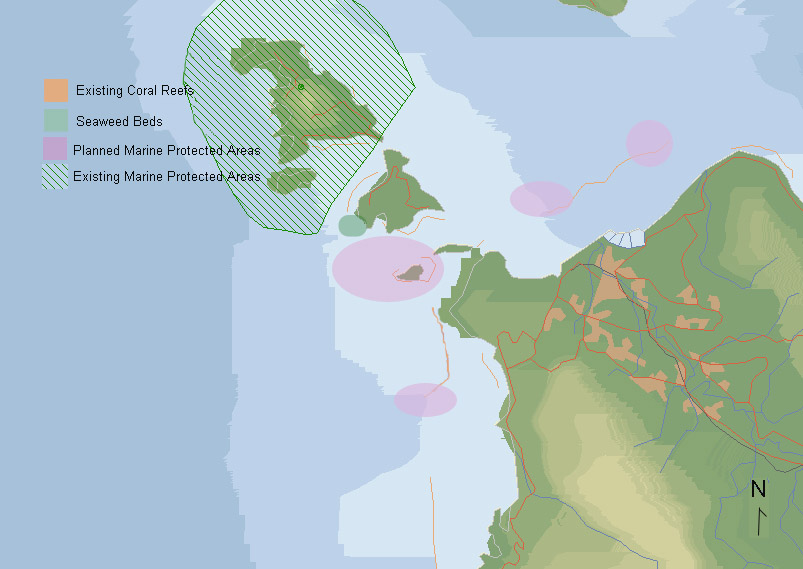
 |
| SeKarang! Save the Coral Reef! |
| Coral | Indonesia | Pollution and Sedimentation | Destructive Fishing | Over Fishing |
| Coral Facts: Why are Coral Reefs Valuable? |
| + Serve as shelter for tens of thousands of non-fish species. |
| + Protect an estimated 15% of all beaches and coastlines from storms and erosion by reducing the action of ocean waves. |
| + Contain many new or still unexplored materials that may represent medical breakthroughs and are currently a source for many pharmaceutical compounds. |
| + Are made of polyps that remove carbon dioxide from the atmosphere as part of the carbon cycle. |
+ Serve as tourist attractions and building materials in many parts of the world. |
Key Factors Affecting the Degradation of Coral Reefs: |
The coral reefs of Southeast Asia are the most threatened in the world. Like all reefs, they suffer occasional impacts from storms and other natural phenomena. However, burgeoning human populations in the region are putting coral reefs under unprecedented pressure. Stresses can be chronic, such as routine discharge of sewage, frequent sedimentation, and long-term overfishing at unsustainable levels. They can also be acute, as in the case of blast fishing or a month of unusually warm water temperatures. Although coral reefs can adapt to chronic stresses in some cases, ongoing pressure prevents recovery from acute stresses and can result in lower levels of biodiversity. From a management point of view, the degradation of coral reefs, according to the World Bank (1998), is mainly related to four major factors i.e. poor management of existing threats, unclear institutional mandates and inadequate institutional capacity, a weak policy and legal framework, and insufficient information. These factors complement one another; therefore, cannot be separated in the analysis. So far, government efforts to reduce the degradation of coral reefs are still limited. The existing policies and regulations fail to properly address marine issues, especially coastal issues. Although some provinces have established their own provincial regulations for controlling the destruction, such as forbidding the use of bombs or cyanide, and have banned coral mining, these regulations are not effective yet. Often fishermen who use bombs or cyanide are reported to the local authority and the Navy arrests them, but then most of them are freed when their cases are formally processed. The major reason given is because of lack of evidence. In some cases, when there is sufficient evidence they are punished, but are given very light sentences such as a jail term of only a few weeks, or a requirement to report periodically to the police office. These punishments are so weak, that they do not stop illegal extraction. In addition, marine institutional capacity in Indonesia is still weak. The number of marine authority staff and their capability in managing marine resources is still limited. |
| Resource: http://www.reefbase.org |
|
Photo: Reefbase/ T. Heeger |
Coral Reefs in Indonesia: |
|
||
Indonesia is the largest supplier of live food fish to the Asian markets with large vessels operating among the more remote reefs, and mostly using cyanide (although illegal since 1995). Muro-ami fishing has significant impacts in a number of areas, including Kepulauan Seribu. This involves the use of large nets and large groups of fishers, often children, who swim with poles or rocks on ropes and smash the reef surface to frighten fish up into the nets. The impacts of trawling on submerged reef systems are less well known, in part because the location and extent of these reefs is unknown.
Coastal development causes considerable problems, particularly in the western half of the country. Extensive deforestation has greatly exacerbated the natural influences of freshwater and sediment discharge on reef growth and condition, and these impacts are continually expanding to new areas. Urban and industrial pollution is widespread, entering coastal areas through rivers and discharge pipes. In 1998 it was reported that there was no sewage treatment plant in any major coastal city. Agricultural development is leading to increased inputs of nutrients and chemicals, and their effects are now widely apparent. In a gradient across the Spermonde Archipelago, for example, there is a rapid decline in biodiversity and coral cover closely linked with proximity to the highly polluted coastline approaching Makassar. Coral cover at 68 kilometers distance from the town is over 65 percent, dropping to 14 percent at 1.3 kilometers. Mangroves have been widely removed, often for the development of shrimp ponds, but also for commercial woodchip or pulp production, or due to general overexploitation by growing coastal populations. Coral mining is also common, with corals being used for various purposes including building (houses, road foundations, sea walls and jetties), to lime production (for mortar), and decorative use both within the country and for export. |
| Prototype Design: |
I selected three different scenarios that coral reefs are negatively effected by and designed prototypes for each. Using "At Risk Maps" of coral reefs in Indonesia I located a site where each scenario could likely occur. The following prototypes are for: Pollution and Sedimentation, Destructive Fishing, and Over Fishing. |
Pollution and Sedimentation: |
| Prototype Design for Location of High Risk: |
 |
| Typical Section of Prototype: |
 |
Destructive Fishing: |
Poverty is a big issue in coastal areas as indicated by low and unstable incomes of coastal people. This is mainly due to their work that is highly dependent on the seasons, unlike that of inland people who can work throughout the year. Most fishermen do not fish during the wet season or the strong wind season, during these times they mainly do nothing, although some of them work inland as farmers. During the fishing season fish prices are usually low, while during the non-fishing season, when fish are scarce, fish traders, middlemen and boat owners often set prices artificially low. Consequently, most fishermen, for their daily life are dependent on a few people who have capital, usually the fish traders or boat owners, often known as boss, tauke or punggawa. Patron-client relationships are common in coastal villages. Boss, tauke or punggawa seem to be rescuers for coastal people because they always provide them with help, such as lending fishermen money and other daily needs. Greed is also an important reason for the destructive patterns of coral reef use, usually practiced by a small group of people who have capital. Their motives differ from the poor coastal villagers, and they wish to gain higher profits, the easy way. In addition to economic purposes, the destructive practices are also due to lack of knowledge and information. However, some people understand that their activities have negative impacts on the surrounding environment, but they ignore the damage they cause and continue to use unsound practices. They still use bombs although they understand bombs destroy reefs. |
Ways to effectively protect coral reefs from destructive fishing: |
1. Educate the locals and fisherman about the importance of healthy reefs. |
|
| Types of Artifical Reefs: | ||
EcoReef: |
||
|
||
Completed in mid-January 2004, the results to date have already been impressive. The ceramic "snowflakes", designed to mimic a branching coral thicket, immediately attracted large numbers of both schooling and sedentary fishes to the previously barren and lifeless rubble field. Benthic recruitment to the modules has been rapid, with coralline algae, bryozoans, vermetid worms, tunicates, and hard coral recruits now covering the modules. Perhaps most encouragingly, over one hundred coral fragments transplanted to the EcoReef modules (by simply wedging between the ceramic spines) have shown 100% survival, with nearly two-thirds of the fragments cementing to the modules and laying down new tissue over the ceramic in the first two months. |
||
In the short term, even large-scale deployments look natural, especially with live coral transplants on the modules. In the long term, the branching design (combined with the inherent fragility of ceramic) allows the modules to fragment and disperse as living corals colonize them. Broken module branches will become incorporated into reef sediments or can help establish new coral colonies. In this respect, EcoReefs imitates the life history of branching coral colonies. Ultimately, biological reef will overtake and replace the ceramic structure, leaving minimal long-term evidence of human intervention. |
||
Because the module components are mass-produced and shipped in large lots, deployments can be done at comparatively low cost. For example, 1,200 modules will construct a dense reef 10 meters wide by 100 meters long for under US$70 per square meter in materials costs. |
||
Resource: www.ecoreefs.com |
Reef Balls: |
||
Reef Balls are made of a special, marine friendly, concrete and are designed to mimic natural reef systems. They are used around the world to create habitats for fish and other marine and freshwater species. Reef Balls are made in many sizes to best match the natural reef type which is being mimicked. The most common sizes are named. |
||
The concrete used to make Reef Balls features W.R. Grace's Force 10,000 micro silica to create a super high strength, abrasion resistant, concrete that has a pH similar to natural sea water. Micro silica gives Reef Balls an expected life of 500 or more years. |
||
|
||
Resource: http://www.reefball.org/pastproj.htm |
BioRock: |
||||
Biorock is a radical new approach to artificial reef construction by means of Mineral Accretion to literally grow reefs. Mineral Accretion is a chemical process pioneered and patented by Professor Wolf Hilbertz and Dr. Tom Goreau, two marine scientists. |
||||
|
||||
Reefs of any configuration and size can be grown for purposes of reef restoration and shore protection. They are growing life support systems, bringing about rich and beautiful ecologies. Mineral accretion technology is unique because it is the only method which produces natural limestone, the material which also constitutes coral skeletons, reefs and sand. As a result, primary settlers and young corals readily settle on the substrate. Naturally settled corals, attached corals, coralline algae, bivalves, and a host of other organisms grow at exceptionally fast rates on these third generation reefs. These growing reefs allow corals to thrive, even when water quality conditions have deteriorated to the point of killing surrounding corals. Coral growth rates are greatly accelerated in comparison with corals of the same species on nearby reefs. The increase of growth rate caused by mineral accretion is about 3 to 5 times faster than normal, and can be as high as 10 times faster. All construction can be done using locally available materials. |
||||
Resource: For more information regarding the use of Biorock in Indonesian and other countries check out: http://www.globalcoral.org |
| Prototype Design for Location of High Risk: |
 |
| Typical Section of Prototype: |
 |
| Over Fishing: |
The demand in wealthy Southeast Asian countries and other nations around the world for marine aquarium fish, live reef food fish, pelagics, and bottomfish has further fueled regionwide exploitation of certain species. Overfishing is a complex problem with varied impacts on coastal communities, the economy, and coastal ecosystems. If effectively managed, fisheries can provide a renewable source of food and livelihoods, but in Southeast Asia, many fish species are currently overexploited. Coral reefs are capable of supporting low levels of fishing sustainably, especially when the fishing is done with nondestructive gear and effort is spread among several species of carnivorous fishes. Fishing effort on any given species should not cause it to decline to the point where it is vulnerable to natural fluctuations in survival rate. However, widespread poverty and the generally open-access nature of coral reef fisheries in the region can cause people to enter or remain in reef fisheries until the average fisher makes no net profit because of high effort and low catch. Overfishing can also cause the mix of fish species to change radically and total fish abundance to drop by an order of magnitude. Moreover, because fish play an integral role in the balance of the coral reef ecosystem, their removal makes reefs less resilient to natural and anthropogenic disturbances. Without the normal suite of fish and invertebrates, corals are more likely to be replaced by algae that prevent coral settlement and growth. When overfishing is caused by large-scale commercial operations, government regulations and enforcement may be the key to reducing the problem. However, where coral reefs are adjacent to crowded coastlines, effective fisheries management is crucial. Key elements in improving compliance with fishing regulations include the development of alternative livelihoods, the implementation of small fishing reserves, and the involvement of fishers in resource decision making. Resource: http://www.reefbase.org |
Ways to effectively protect coral reefs from over fishing: |
1. Educate villagers and fisherman about the importance of sustainable fishing. |
| Prototype Design for Location of High Risk: |
 |
| Resources: |
| http://www.reefbase.org |
| http://www.reefbase.org/resources/res_overview.asp?changearea=true&Region=0&country=IDN |
| www.coral.org |
| http://www.globalcoral.org |
|